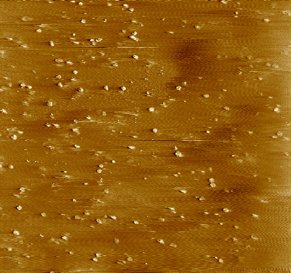| Original color image/movie frame | Restored color image/movie frame |
 ppm file |
 ppm file |
 ppm file |
 ppm file |
Use image restoration, image denoising, and color correction algorithms to fix the defects in the given color image. Noted that the restored image only gives you a reference after color correction. Other defects like scratches in the film still needs to be removed.
| Original color image/movie frame | Restored color image/movie frame |
 ppm file |
 ppm file |
 ppm file |
 ppm file |
The atomic force microscope (AFM) has become an instrument of choice for high-resolution imaging in both material and biological research since its invention in 1986 [1]. For biological applications, the ability to image samples without fixation or staining and most importantly in liquid environment has enabled nano-scale imaging that is beyond the capabilities of the electron microscope.
Generally imaging is pursued to evaluate structural features of the sample or perhaps identify some structural changes in the sample that are induced by the investigator. However, AFM images usually have high amount of non-uniform background noise that noise can easily be mistaken for valid object features.
The following is an AFM image (ppm version) of E.Coli spheroplasts where cells with their outer wall enzymatically digested away

Steganography deals with hiding information in a cover so that not only the information, but the very existence of the information is hidden. It differs from digital watermarking for its different requirements on imperceptibility (including both visual imperceptibility and statistical imperceptibility), robustness (robust against cover modifications), security (how easy it is to break the embedded message), and capacity (how much information can be hidden in a certain media). While it is impossible to simultaneously satisfy all these requirements, steganography needs to achieve large capacity, high security level, and high imperceptibility, but does not have to be robust against cover modifications; on the other hand, digital watermarking has relatively low requirements on imperceptibility, security and capacity, but it must be robust against both accidental faults (e.g. noise) and malicious faults (e.g. attacks like clipping, scaling of the cover). Steganography is sometimes referred to as covert communication. A typical application example is to transfer secret messages embedded in images using a public website. Although the images are accessible to all users, only those with the secret key(s) can view the hidden information.
Reference: Information hiding techniques for steganography and digital watermarking [electronic resource] / Stefan Katzenbeisser, Fabien A.P. Petitcolas, editors. Boston : Artech House, 2000.
The goal of this project is to identify patterns that indicate the layout of the many well preserved interior and exterior structures of the earliest known Roman fort in Jordan, dating from the early 2nd century to the late 4th century AD. The 200m by 150m fort was surveyed using both ground penetration radar (GPR) and magnetic gradiometry using a 1m profile spacing.
A bit history of Humayma is provided. Some background on near-surface geophysics study including both magnetic and GPR is also given. This file (pdf) includes a set of figures that gives you a nutshell of problem to be solved. The images and the references are provided by Dr. Greg Baker at UT.
A ground penetration radar image and a magnetic image for near-surface geophysics surveys on a 4th century Roman fort in Jordan (gpr.pgm) (I had some problem converting the magnetic images. So only GPR images are given)